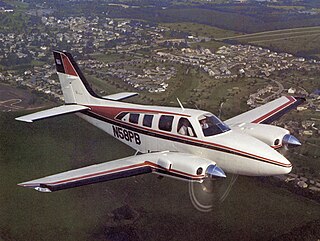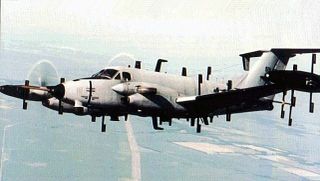 W
WThe Beechcraft Model 18 is a 6- to 11-seat, twin-engined, low-wing, tailwheel light aircraft manufactured by the Beech Aircraft Corporation of Wichita, Kansas. Continuously produced from 1937 to November 1969, over 9,000 were built, making it one of the world's most widely used light aircraft. Sold worldwide as a civilian executive, utility, cargo aircraft, and passenger airliner on tailwheels, nosewheels, skis, or floats, it was also used as a military aircraft.
 W
WThe Beechcraft Model 34 "Twin-Quad" was a prototype airliner designed and built by Beechcraft in the period between World War II and the Korean War. At this time many aircraft manufacturers in the United States anticipated a boom in civil aviation and a large number of designs left the drawing board only to ultimately fail. The Model 34 was one of these failures, partly because of its unusual design, and partly because of the thousands of ex-military transport aircraft that were available at the time for a fraction of the price of a new aircraft.
 W
WThe Beechcraft Model 99 is a civilian aircraft produced by Beechcraft. It is also known as the Beech 99 Airliner and the Commuter 99. The 99 is a twin-engine, unpressurized, 15 to 17 passenger seat turboprop aircraft, derived from the earlier Beechcraft King Air and Queen Air. It uses the wings of the Queen Air, the engines and nacelles of the King Air, and sub-systems from both, with a specifically-designed nose structure.
 W
WThe Beechcraft 1900 is a 19-passenger, pressurized twin-engine turboprop fixed-wing aircraft that was manufactured by Beechcraft. It was designed, and is primarily used, as a regional airliner. It is also used as a freight aircraft and corporate transport, and by several governmental and military organisations. With customers favoring larger regional jets, Raytheon ended production in October 2002.
 W
WThe Beechcraft XA-38 "Grizzly" was a World War II-era ground attack aircraft, developed by Beechcraft, but never put into production. The Grizzly was to have been fitted with a forward-firing 75 mm cannon, to penetrate heavily armored targets.
 W
WThe AQM-37 Jayhawk is an air-launched supersonic target drone manufactured by Beechcraft capable of simulating inbound ICBM warhead packages for fleet shoot-down exercises.
 W
WThe Beechcraft AT-10 Wichita was an American World War II trainer built for the United States Army Air Forces (USAAF) by Beechcraft. It was used to train pilots for multi-engined aircraft such as bombers.
 W
WThe Beechcraft Baron is a light, twin-engined piston aircraft designed and produced by Beechcraft, introduced in 1961. A development of the Travel Air, it remains in production.
 W
WThe Beechcraft Bonanza is an American general aviation aircraft introduced in 1947 by Beech Aircraft Corporation of Wichita, Kansas. The six-seater, single-engined aircraft is still being produced by Beechcraft and has been in continuous production longer than any other aircraft in history. More than 17,000 Bonanzas of all variants have been built, produced in both distinctive V-tail and conventional tail configurations; early conventional-tail versions were marketed as the Debonair.
 W
WThe Beechcraft Bonanza is an American general aviation aircraft introduced in 1947 by Beech Aircraft Corporation of Wichita, Kansas. The six-seater, single-engined aircraft is still being produced by Beechcraft and has been in continuous production longer than any other aircraft in history. More than 17,000 Bonanzas of all variants have been built, produced in both distinctive V-tail and conventional tail configurations; early conventional-tail versions were marketed as the Debonair.
 W
WThe Beechcraft C-12 Huron is the military designation for a series of twin-engine turboprop aircraft based on the Beechcraft Super King Air and Beechcraft 1900. C-12 variants are used by the United States Air Force, United States Army, United States Navy and United States Marine Corps. These aircraft are used for various duties, including embassy support, medical evacuation, as well as passenger and light cargo transport. Some aircraft are modified with surveillance systems for various missions, including the Cefly Lancer, Beechcraft RC-12 Guardrail and Project Liberty programs.
 W
WThe Beechcraft CT-134 Musketeer is a military training derivative of the Musketeer built by Beechcraft for the Canadian Forces. The CT-134 was a single engine, low-wing, four-seat light aircraft with fixed landing gear and a limited aerobatic capability.
 W
WThe Beechcraft Model 76 Duchess is an American twin-engined monoplane built by Beechcraft intended partly as a low cost introduction to twin-engine aircraft.
 W
WThe Beechcraft 60 Duke is an American-built twin-engine fixed-wing aircraft created by Beechcraft. The aircraft has retractable tricycle landing gear and a pressurized cabin. The two piston engines are turbocharged and the turbochargers also pressurize the cabin with bleed air.
 W
WThe Hawker 400 is a light business jet. Initially designed and built by Mitsubishi, it has been further developed and updated by the Beech Aircraft Company, now part of Textron Aviation.
 W
WThe Hawker 800 is a mid-size twinjet corporate aircraft. It is a development of the British Aerospace BAe 125, and was assembled by Hawker Beechcraft.
 W
WThe Hawker 4000, originally known as the Hawker Horizon, is a super-midsize business jet developed by Hawker Beechcraft.
 W
WThe Beechcraft King Air family is part of a line of American utility aircraft produced by Beechcraft. The King Air line comprises a number of twin-turboprop models that have been divided into two families. The Model 90 and 100 series developed in the 1960s are known as King Airs, while the later T-tail Model 200 and 300 series were originally marketed as Super King Airs, with the name "Super" being dropped by Beechcraft in 1996.
 W
WThe Beechcraft Super King Air family is part of a line of twin-turboprop aircraft produced by Beechcraft. The Model 200 and Model 300 series were originally marketed as the "Super King Air" family; the "Super" designation was dropped in 1996. They form the King Air line together with the King Air Model 90 and 100 series.
 W
WThe Beechcraft L-23 Seminole was the United States Armed Forces designation for the Beechcraft Twin Bonanza and Queen Air aircraft in its inventory.
 W
WThe MQM-61 Cardinal was a target drone designed and built by Beechcraft.
 W
WThe Beechcraft MQM-107 Streaker is a reusable, turbojet powered, target towing drone primarily used by the United States Army and the United States Air Force for testing and training. The US Army uses the drone for testing various surface-to-air missile systems such as the FIM-92 Stinger and the MIM-104 Patriot. The US Air Force uses them in practice engagements for their air-to-air missiles like the AIM-9 Sidewinder and the AIM-120 AMRAAM.
 W
WThe Beechcraft Musketeer is a family of single-engined, low-wing, light aircraft that was produced by Beechcraft. The line includes the Model 19 Musketeer Sport, the Model 23 Musketeer, Custom and Sundowner, the Model 23-24 Musketeer Super III the retractable gear Model 24-R Sierra and the military CT-134 Musketeer.
 W
WThe Beechcraft Premier I is a light business jet aircraft manufactured by the Beechcraft division of Hawker Beechcraft. The aircraft was designed to compete with the Cessna CitationJet series of aircraft.
 W
WThe Beechcraft Queen Air is a twin-engined light aircraft produced by Beechcraft in several versions from 1960 to 1978. Based upon the Twin Bonanza, with which it shared key components such as wings, engines, and tail surfaces, but featuring a larger fuselage, it served as the basis for the highly successful King Air series of turboprop aircraft. It is often used as a private aircraft, a utility, or a small commuter airliner. Production ran for 17 years.
 W
WThe Beechcraft RC-12 Guardrail is an airborne signals intelligence (SIGINT) collection platform based on the Beechcraft King Air and Super King Air. While the US military and specifically the United States Army have numerous personnel transport variants of the King Air platforms referred to with the general C-12 designation, the RC-12 specification refers to a heavily modified platform that collects SIGINT through various sensors and onboard processors.
 W
WThe Beechcraft Model 77 Skipper is a two-seat, fixed tricycle gear general aviation airplane, originally designed for flight training but also used for touring and personal flying.
 W
WThe Beechcraft Model 17 Staggerwing is an American biplane with an atypical negative wing stagger. It first flew in 1932.
 W
WThe Beechcraft Starship is a twin-turboprop six- to eight-passenger pressurized business aircraft produced by Beech Aircraft Corporation.
 W
WThe Beechcraft T-6 Texan II is a single-engine turboprop aircraft built by the Raytheon Aircraft Company. A trainer aircraft based on the Pilatus PC-9, the T-6 has replaced the United States Air Force's Cessna T-37B Tweet and the United States Navy's T-34C Turbo Mentor. The T-6A is used by the United States Air Force for basic pilot training and Combat Systems Officer (CSO) training, the United States Navy and United States Marine Corps for primary and intermediate Naval Flight Officer (NFO) training, and by the Royal Canadian Air Force, Greek Air Force, Israeli Air Force, and Iraqi Air Force for basic flight training. The T-6B is the primary trainer for U.S. student naval aviators (SNAs). The T-6C is used for training by the Mexican Air Force, Royal Air Force, Royal Moroccan Air Force, and the Royal New Zealand Air Force.
 W
WThe Beechcraft T-34 Mentor is an American propeller-driven, single-engined, military trainer aircraft derived from the Beechcraft Model 35 Bonanza. The earlier versions of the T-34, dating from around the late 1940s to the 1950s, were piston-engined. These were eventually succeeded by the upgraded T-34C Turbo-Mentor, powered by a turboprop engine. The T-34 remains in service more than six decades after it was first designed.
 W
WThe Beechcraft XT-36 was an American twin-engine trainer-transport aircraft project of the early 1950s. Due to a change in requirements, the project was cancelled before any examples of the type were built.
 W
WThe Beechcraft Travel Air was a twin-engine development of the Beechcraft Bonanza. It was designed to fill the gap between the single engine Model 35 Bonanza and the much larger Model 50 Twin Bonanza, and ultimately served as the basis for its replacement, the Baron.
 W
WThe Beechcraft Model 50 Twin Bonanza is a small twin-engined aircraft designed by Beechcraft as an executive transport for the business market. It was developed to fill a gap in Beechcraft's product line between the single-engined Model 35 Bonanza and the larger Model 18. The Twin Bonanza is about 50% larger than the Bonanza, has more powerful engines, and is significantly heavier, while in its earliest form having only half the passenger capacity of the Model 18.